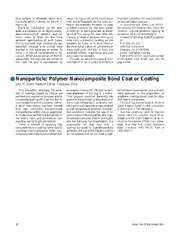
NASA Technical Reports Server (NTRS) 20110003030: Nanoparticle/Polymer Nanocomposite Bond Coat or Coating PDF
Preview NASA Technical Reports Server (NTRS) 20110003030: Nanoparticle/Polymer Nanocomposite Bond Coat or Coating
tube surface, or sidewalls, rather than curve 2 in figure (b), which could be cy- Propulsion Laboratory. For more information, the body, which is shown by the I-V in cled and propagated via the tube sur- contact [email protected]. figure (a). face or the sidewalls. However, no mea- In accordance with Public Law 96-517, Electrical conduction via the side- sureable currents for the tube grown the contractor has elected to retain title to this walls is a necessity for dc NEMS (nano- directly on Si were observed as shown invention. Inquiries concerning rights for its electromechanical system) applica- by curve 3 in figure (b), even after test- commercial use should be addressed to: tions, more so than for the field ing over a range of samples. This could Innovative Technology Assets Management emission applications of such tubes. arise from a dielectric coating on the JPL During the tests, high conductivity was sidewalls for tubes on Si. As a result of Mail Stop 202-233 expected, because both probes were the directional nature of ion bombard- 4800 Oak Grove Drive shorted to the substrate, as shown by ment during dc PECVD, Si from the Pasadena, CA 91109-8099 curve 1 in the I-V characteristic in fig- substrate is likely re-sputtered and pos- E-mail: [email protected] ure (b). When a tube grown on NbTiN sibly coats the sidewalls. Refer to NPO-47157, volume and number was probed, the response was similar to This work was done by Anupama B. Kaul of this NASA Tech Briefs issue, and the the ≈100 nA and is represented by and Abdur R. Khan of Caltech for NASA’s Jet page number. Nanoparticle/Polymer Nanocomposite Bond Coat or Coating John H. Glenn Research Center, Cleveland, Ohio This innovation addresses the prob- an organic compound intended to facil- temperature requirement, and a compa- lem of coatings (meant to reduce gas itate dispersion of the clay in a matrix. rable approach to the preparation of permeation) applied to polymer matrix That organic modifier generally de- graphene coatings/bond coats for poly- composites spalling off in service due to grades at the processing temperature of mer matrix composites. incompatibility with the polymer matrix. many high-temperature polymers, ren- This work was done by Sandi G. Miller of A bond coat/coating has been created dering the clay useless as a nano-additive Glenn Research Center. Further information that uses chemically functionalized to high-temperature polymers. However, is contained in a TSP (see page 1). nanoparticles (either clay or graphene) this innovation includes the use of or- Inquiries concerning rights for the com- to create a barrier film that bonds well to ganic compounds compatible with high- mercial use of this invention should be ad- the matrix resin, and provides an out- temperature polymer matrix, and is suit- dressed to NASA Glenn Research Center, In- standing barrier to gas permeation. able for nanoclay functionalization, the novative Partnerships Office, Attn: Steven There is interest in applying clay preparation of that clay into a Fedor, Mail Stop 4–8, 21000 Brookpark nanoparticles as a coating/bond coat to coating/bondcoat for high-temperature Road, Cleveland, Ohio 44135. Refer to a polymer matrix composite. Often, nan- polymers, the use of the clay as a coating LEW-18607-1. oclays are chemically functionalized with for composites that do not have a high- 20 NASA Tech Briefs, January 2011
